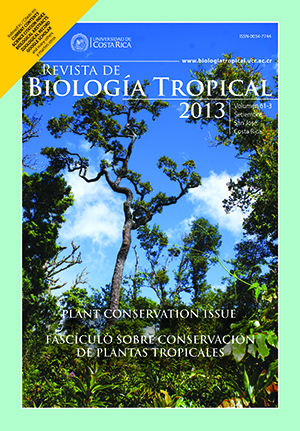Abstract
Environmental heterogeneity mostly dominated by differing light regimes affects the expression of phenotypic plasticity, which is important for plant growth and survival, especially in the forest understory. The knowledge about these responses to this heterogeneity is a key factor for forest restoration initiatives. In this study, we determine several phenotypic responses to contrasting light conditions in five native tree seedling species of La Cangreja National Park, Central Pacific of Costa Rica, four of them with threatened or relict populations. After 14 weeks at a medium gap condition (24% of full sun), seedlings were transferred and acclimated for 11 weeks to three different natural light regimes: large gap (LG), medium gap (MG) and small gap (SG), corresponding to 52%, 24%, 9% of the mean direct and indirect radiation at each site from full sun. Growth, biomass allocation and leaf gas exchange were measured after the acclimation period. Four species strongly reduced relative growth rate (RGR) in the lower light condition. Total biomass (TB) and RGR were different in Hymenaea courbaril and Platymiscium curiense. H. courbaril and Astronium graveolens had significant changes in the maximum assimilation rate, with a mean value in the LG of 11.02 and 7.70μmolCO2/m2s, respectively. P. curuense showed the same trend and significant changes in RGR and biomass allocation. Aspidosperma myristicifolium and Plinia puriscalensis showed no adjustments to the light regimes in any of the measured variables. This study remarks the importance of determining the growth and physiological performance of these tree native species. It also demonstrates that the most threatened species are those with the less plastic responses to the light regimes, which stresses the difficult situation of their natural populations. This study highlights an urgent definition of the conservation and restoration needs of the degraded forests of the Costa Rican Central Pacific area, where these species dwell.##plugins.facebook.comentarios##
Downloads
Download data is not yet available.


